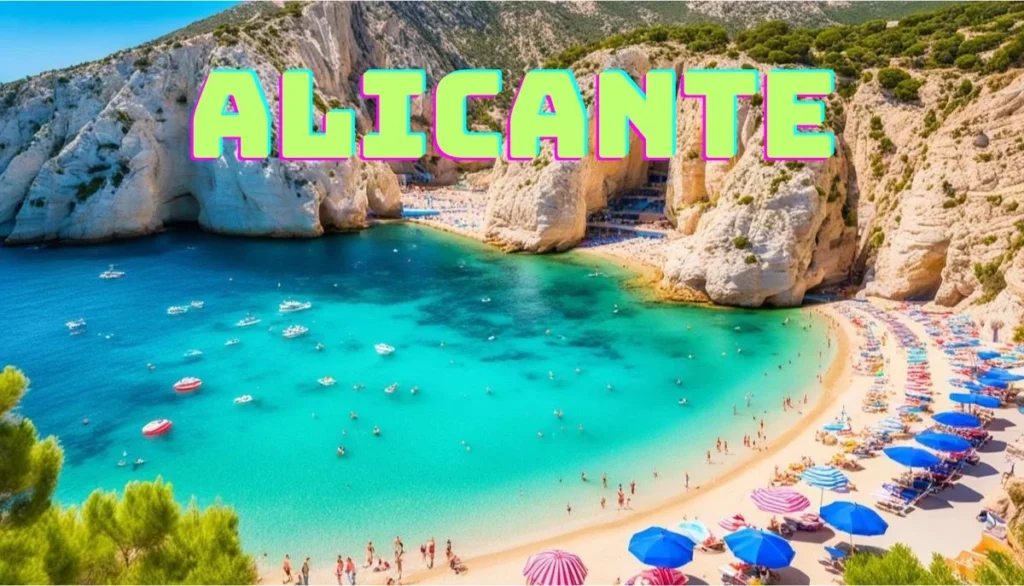Disclaimer: I have affiliate links in this post and receive a commission on any purchases you make at no cost to you. It’s one of the ways I support my site.
Welcome to Alicante, Spain! Alicante is located on the beautiful Costa Blanca. It offers the perfect mix of sunshine, rich history, and Mediterranean charm. If you’re planning a trip to Alicante, this ultimate guide will provide you with all the information you need. It will help you make the most of your visit. From travel tips to tourist attractions, we have you covered.
Key Takeaways:
- Alicante, Spain is a popular destination known for its sun, history, and Mediterranean charm.
- This guide will provide you with essential travel tips and important tourist information for your visit to Alicante.
- Whether you’re interested in exploring historical sites, relaxing on pristine beaches, or indulging in delicious cuisine, Alicante has something for everyone.
- Plan your visit to Alicante based on the optimal travel times and transportation options available.
- Don’t miss out on experiencing the city’s iconic sites, enjoying the sun on Alicante’s beautiful beaches, and savoring the local gastronomy.
Unveiling Alicante Spain: A Magnet for Tourists
Alicante is a tourist magnet on the Costa Blanca in Spain. It attracts millions of visitors every year. This charming city offers a colorful coastline. It’s known as the Costa Blanca. It stretches for over 200 kilometers along the Mediterranean Sea.
The Costa Blanca has crystal-clear waters and sandy beaches. It provides an idyllic setting for beach lovers and outdoor enthusiasts. Alicante is a gem on Spain’s eastern coast. It’s a gateway to the Costa Blanca. This name means “White Coast,” reflecting its shimmering vast sandy beaches.
The allure of Alicante and the Costa Blanca lies not just in their visual appeal. It also lies in the wealth of experiences they offer to visitors. For those who prefer more active pursuits, the region provides ample hiking, cycling, and water sports opportunities. You can sail on the Mediterranean. You can also explore the rugged trails of the Sierra de Aitana. There are many ways to engage with the natural landscape.
Alicante and the Costa Blanca offer a blend of leisure, adventure, and cultural depth. This makes it an attractive destination for travelers seeking a comprehensive holiday experience. You can lounge on the beach. You can delve into the rich historical tapestry. You can sample the local cuisine. You can take part in the dynamic festival scene. There’s something here for every type of visitor.
Introduction to a Colorful Coastline: Costa Blanca and Beyond
The Costa Blanca is a picturesque stretch of coastline. It includes not only Alicante but also a variety of other coastal towns and villages. This coastline offers something for everyone. It ranges from bustling resort towns to hidden fishing villages. Visitors can explore the charming streets of Altea.
They can relax on the sandy beaches of Benidorm. Or discover the historical sites of Denia. Each town along the Costa Blanca has its unique charm and attractions. This makes it an ideal destination for those seeking diverse experiences.
The Costa Blanca is located in the province of Alicante, Spain. It is a diverse and enchanting stretch of coastline. It attracts millions of visitors each year. The blend of natural beauty, historical heritage, and modern amenities is why. Let’s take a closer look at some of the key locations along this vibrant coast:
Alicante: The capital of the province, the city is a historic port city with a vibrant urban life. Visitors can explore the medieval Castle of Santa Bárbara. It’s perched on Mount Benacantil. It offers panoramic views of the city and the Mediterranean Sea. The Explanada de España, a palm-lined promenade, is perfect for leisurely walks.


Altea is known for its white houses and the blue-domed Church of the Virgin of the Consol. It offers a more tranquil experience. Its charming old town has narrow cobblestone streets. The town offers art galleries, craft shops, and quaint cafés. The waterfront promenade is lively and offers a beautiful setting for evening strolls.
Benidorm was once a small fishing village. It has transformed into one of the most popular and bustling resort towns on the Costa Blanca. It’s renowned for its vibrant nightlife, long sandy beaches, and skyscrapers. Theme parks like Terra Mítica and water parks such as Aqualandia add to the family appeal.
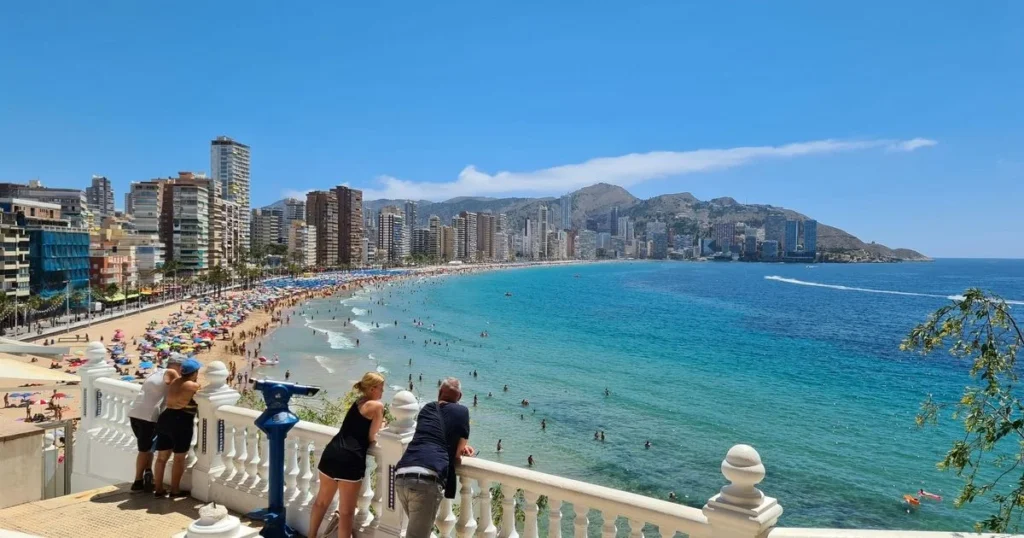
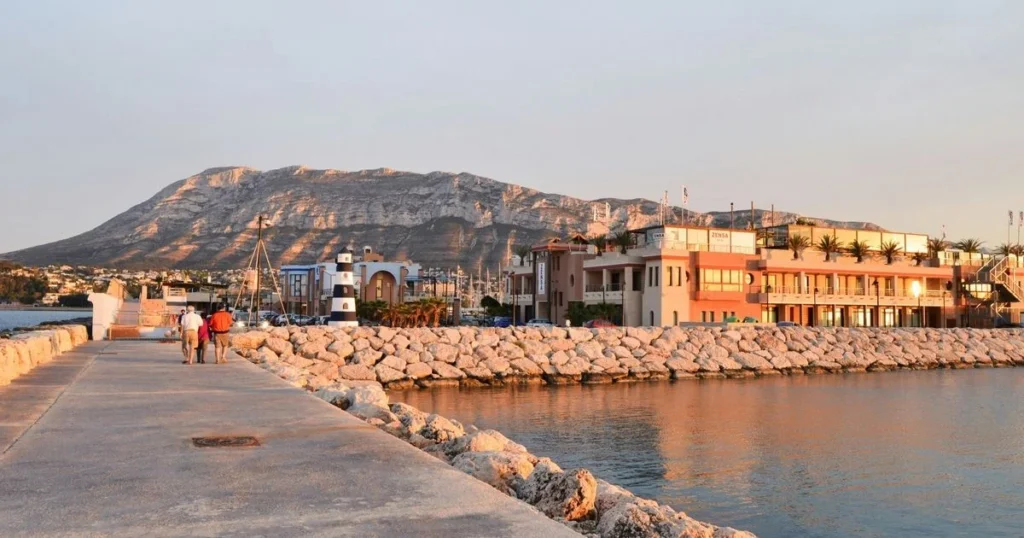
Denia is rich in history. It boasts a well-preserved castle that dates back to the 11th and 12th centuries. The town has a lively port from where ferries go to the Balearic Islands. Shops, bars, and restaurants line Denia’s main street, Marqués de Campo. The town is also known for its culinary scene, particularly seafood.
Calpe is famous for the Penon de Ifach. It’s a massive limestone formation that juts out into the sea and is now a nature reserve. It offers a combination of historical sites and beautiful beaches. The old town features narrow streets, ancient buildings, and the ruins of a Roman villa.
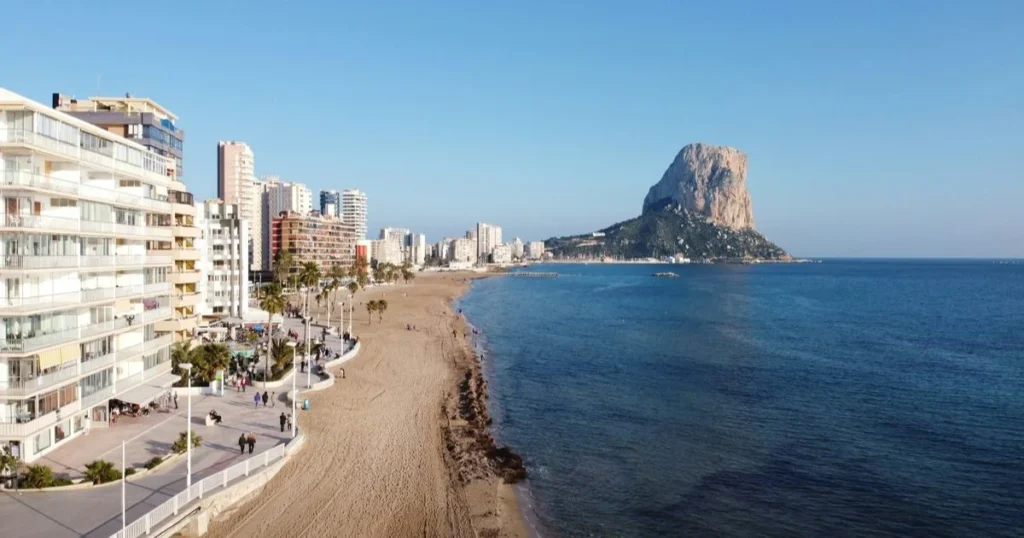

Javea (Xabia) is nestled between rocky headlands. It boasts a rugged coastline with hidden coves and sandy beaches. The old town is a maze of narrow streets with gothic buildings. The Arenal area offers a sandy beach with a promenade lined with restaurants and bars.
Torrevieja was once a salt-mining and fishing village. Now it is known for its salt lakes, an important habitat for flamingos and other bird species. The town offers a variety of beaches, a bustling boardwalk, and a vibrant market.

The Costa Blanca’s appeal lies in its diversity. It ranges from the hustle and bustle of Benidorm to the quiet charm of Altea, and the historical allure of Denia.
Alicante’s Allure: Why This Spanish Gem Attracts Millions
Alicante’s allure as a tourist destination goes beyond its stunning coastline. The city is steeped in history and culture. It has a wealth of attractions and activities to explore. Santa Bárbara, an ancient castle, is perched atop Mount Benacantil. From there, visitors can enjoy breathtaking views of the city and the Mediterranean Sea.
The city is also known for its vibrant festivals and events. For example, the Bonfires of Saint John and the Moors and Christians Festival showcase the city’s rich cultural heritage. Alicante offers a wide array of attractions that suit every interest. Also, it has historical and cultural offerings. The city boasts excellent museums. For example, the Archaeological Museum of Alicante houses fascinating artifacts and exhibits.
Outdoor enthusiasts can explore the nearby natural parks. For example, the Sierra de Mariola. They can also embark on hiking adventures in the surrounding mountains. Alicante has sunny weather, friendly locals, and many activities. It continues to captivate and delight millions of tourists year after year.
Diving into History: Alicante’s Rich Past
Alicante, a city with a captivating history, has roots that date back thousands of years. Various civilizations have left their mark on the city’s architecture, culture, and traditions. This has been happening from prehistoric times to the present day.
Throughout Alicante, you’ll find a treasure trove of historical attractions. They showcase the city’s rich past. The iconic Castle of Santa Barbara stands tall on Mount Benacantil. It offers panoramic views and a glimpse into the city’s medieval history. Taking a stroll through the Barrio de Santa Cruz feels like stepping back in time. The historic neighborhood has narrow streets and colorful houses.
To delve even deeper into the history of Alicante, visit the city’s archaeological sites. They offer a fascinating glimpse into the civilizations that once thrived here. From the ancient Iberians to the Romans, Moors, and Christians, each era has left its own unique imprint on the city’s cultural heritage.
The city’s history is a rich tapestry. It’s woven from the numerous cultures and civilizations that have made their mark over the millennia. This city is located on the southeastern coast of Spain. It has been a strategically significant location due to its port, which has played a pivotal role in trade and defense throughout the ages.
Prehistoric Beginnings and Ancient Times
Evidence of human habitation in the Alicante area dates back to prehistoric times. Archaeological findings point to settlements from as early as 5000-3000 BC. The earliest inhabitants were likely attracted by the region’s mild climate, fertile land, and the bounty provided by the sea.
By the first millennium BC, the Iberians had settled in the area. They left behind fascinating artifacts, including ceramics and sculptures. The famous Dama de Elche is an Iberian bust from the 4th century BC. The object was not found in Alicante itself. However, it symbolizes the artistic skill and culture of the Iberians in the surrounding region.
Roman and Visigothic Influence
Alicante, known as “Lucentum” during the Roman era, became an important port and trading hub in the Roman province of Hispania. The Romans significantly contributed to the city’s development. They introduced advanced architecture, infrastructure, and social organization.
The remnants of Roman baths, streets, and part of the forum can still be seen in Alicante today. After the fall of the Roman Empire, the Visigoths took control of the region. Their rule is less documented in Alicante’s archaeological record. However, it was an essential link between the Roman and Islamic periods in the Iberian Peninsula.
Islamic and Christian Re-conquest
The Moors seized Alicante in the early 8th century. They ushered in a period of Islamic rule that would last several centuries. Alicante flourished under the Moors. They introduced new agricultural techniques, such as irrigation. They left a lasting imprint on the city’s architecture and culture.
The Castle of Santa Barbara is an iconic part of Alicante’s skyline today. It has origins dating back to this period. It was significantly expanded and modified in later centuries.
The Christian Reconquista regained control of Alicante in the 13th century. This pivotal moment shifted the city’s culture and politics. The Gothic church of St. Mary and the Basilica of St. Nicholas of Bari in Alicante are examples of architecture from this era.
Modern Era and Contemporary Times
Alicante continued to grow in importance through the centuries. It survived pirate attacks, wars, and economic fluctuations. The 19th and 20th centuries brought industrial growth to Alicante. The city also developed as a hub for tourism. It took advantage of its beautiful beaches, pleasant climate, and historical appeal.
Today, Alicante invites visitors and scholars to explore its rich past. They can do this through well-preserved historical sites, museums, and cultural festivals.
To visually transport you into Alicante’s rich history, take a moment to admire this image:
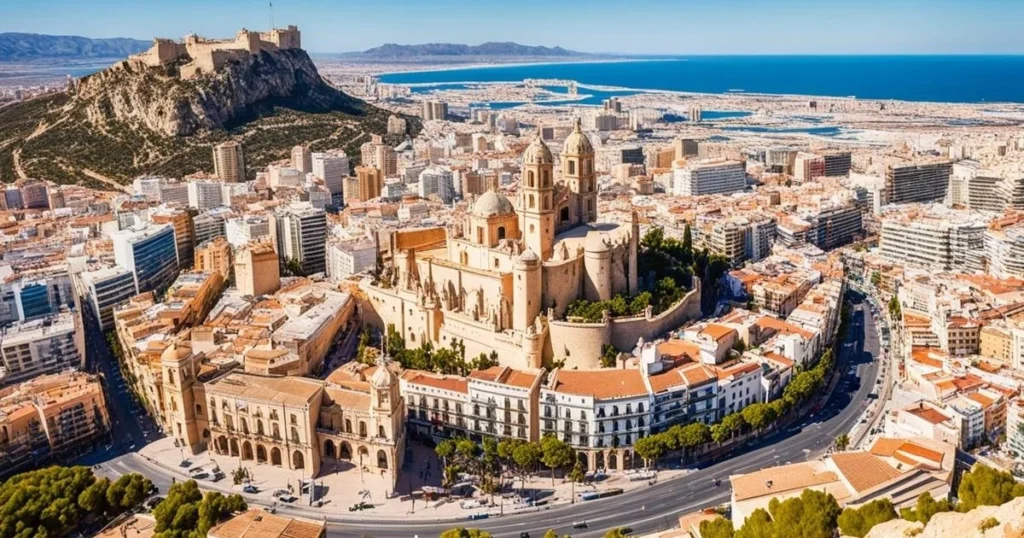
Exploring Alicante’s history is an educational experience. It also provides a deeper understanding of the city’s roots and cultural heritage. So, make sure to set aside time to discover the historical gems that Alicante has to offer.
Optimal Travel Times: When to Visit Alicante
Alicante enjoys a Mediterranean climate, with mild winters and hot summers. So, when is the best time to visit this charming destination? It depends on your personal preferences. Consider what you want to experience during your trip.
Enjoying Alicante’s Climate: Seasonal Highlights
Alicante offers sunny weather and a lively atmosphere in the peak tourist season of summer (June to August). The beaches are buzzing, and there are plenty of events and festivals to enjoy. It’s the perfect time for sunbathing and swimming. You can also immerse yourself in the vibrant energy of the city.
Spring (March to May) and autumn (September to November) are ideal for those seeking pleasant weather, fewer crowds, and lower prices. These seasons have comfortable temperatures. Exploring Alicante’s historical sites, museums, and charming neighborhoods is enjoyable. Also, you’ll have a better chance of finding accommodations and popular attractions without the hustle and bustle.
Dodging the Crowds: Ideal Months for a Quieter Experience
If you’re looking for a quieter experience, consider visiting Alicante in the winter. The winter months in Alicante are December to February. The temperatures are cooler. It’s a great time to explore the city’s cultural attractions. You can also take advantage of discounted rates on accommodations. The streets and attractions are less crowded. You can soak up the authentic atmosphere at your own pace.
Navigating From Alicante Airport to the City Center
Alicante Airport, also known as Alicante-Elche Airport, is the main international gateway to the region. When you arrive, you’ll have various transportation options. This will help you easily reach the city center.
If you prefer the convenience of a taxi, you can find designated taxi stands outside the airport terminals. Taxis are readily available. They provide a direct transfer to your destination in the city center. Keep in mind that taxi fares may vary. It’s advisable to confirm the price with the driver before starting your journey.
An alternative option is to use the efficient bus network. Alicante Airport is well-connected to the city center by bus routes. The routes operate throughout the day. The journey takes around 15-20 minutes. Bus stops are conveniently located near the airport terminals. This budget-friendly option lets you immerse yourself in the local atmosphere as you travel to your destination.
If you prefer the flexibility to explore at your own pace, renting a car is a popular choice. Several reputable car rental companies have counters at Alicante Airport. It is easy to pick up your vehicle upon arrival. Having a rental car gives you the freedom to discover not only the city center but also the surrounding areas at your leisure.
Research and plan your airport transfer in advance. This will ensure a smooth arrival and seamless transition to your accommodation. This way, you can choose the transportation option that best suits your needs. Have all the necessary details ready upon arrival.

| Transportation Option | Advantages | Considerations |
|---|---|---|
| Taxi | – Direct and convenient transfer – No need to navigate public transportation | – Budget-friendly option – Access to the local atmosphere |
| Bus | – Budget-friendly option – Access to local atmosphere | – Bus schedules and frequency |
| Rental Car | – Flexibility to explore at your own pace – Ability to visit surrounding areas | – Parking availability and costs – Familiarize yourself with local driving regulations |
Choose the best transportation option to start your journey in Alicante with ease. Make the most of your time in this vibrant city.
On the Move: Transportation Tips Within Alicante
Exploring Alicante and its surrounding areas is made easy with various transportation options available. There are choices to suit everyone’s needs. You can choose the flexibility of driving or the convenience of public transport.
Driving Explorations: Car Rental Insights
If you want the freedom to explore Alicante at your own pace, renting a car is a great option. It also allows you to venture further into the region. Car rental services are widely available. It’s recommended to book in advance to secure the best rates.
With a rental car, you can easily visit the charming coastal towns. You can also visit hidden beaches and picturesque countryside that surround Alicante. Just keep in mind that parking in the city center can be limited, so plan accordingly.
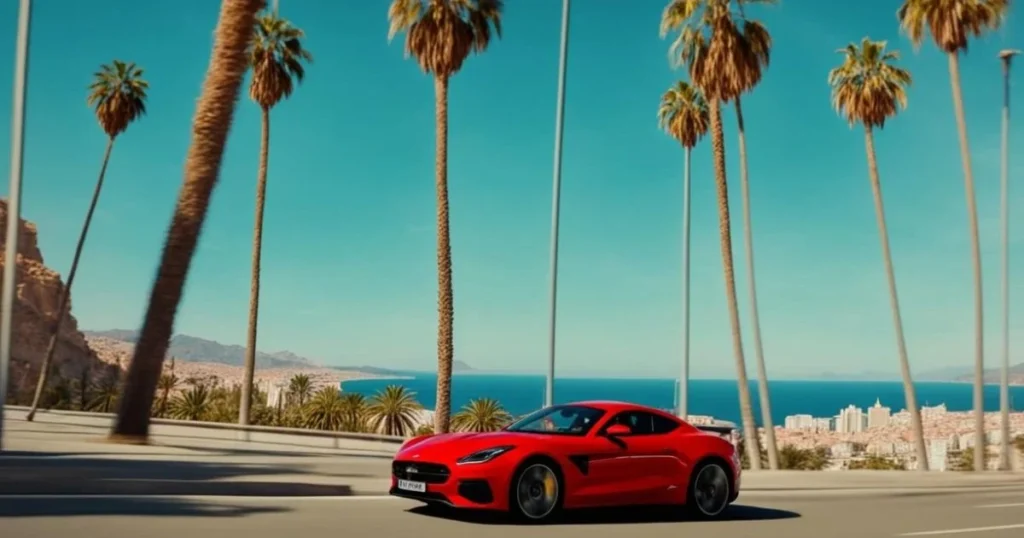
Public vs. Private Transport: Cost and Convenience
If you prefer to let someone else handle the driving, public transport in Alicante is a cost-effective and convenient way to get around. The city has a well-developed network of buses and trains. It makes it easy to reach popular attractions and neighboring towns. Public transport is affordable.
It helps you avoid parking and navigating unfamiliar roads. Whether you’re heading to the beach, exploring historical sites, or dining at local restaurants, public transport can take you there. When choosing between car rental and public transport, consider your travel needs, budget, and preferences.
If you prefer the flexibility and freedom of exploring on your own, renting a car is a great choice. On the other hand, if you value convenience, public transport is a reliable option. It can help you avoid the stress of driving. Ultimately, the choice is yours. It depends on what kind of experience you want to have during your time in Alicante.
The Heart of Alicante: Experiencing the City’s Iconic Sites
Alicante is home to several iconic sites. These sites showcase the city’s heritage, culture, and beauty. Two of the most noteworthy attractions that should not be missed are Santa Bárbara Castle and the Barrio de Santa Cruz.
Santa Bárbara Castle: A Hilltop Haven

Santa Bárbara Castle is a must-visit attraction in Alicante. Mount Benacantil supports this historic fortress. It offers panoramic views of the city and the Mediterranean Sea. The castle has a fascinating history that dates back over a thousand years. Its impressive architecture is a testament to the city’s rich past. Exploring the castle’s rooms, towers, and ramparts is a captivating journey through time. It provides visitors with an immersive experience of Alicante’s cultural and military heritage.
Yes, Santa Bárbara Castle is indeed one of the most iconic visit points in Alicante, Spain. The castle stands majestically on Mount Benacantil. It’s about 166 meters above sea level. The castle dominates the cityscape. It also offers breathtaking views of the city and the azure waters of the Mediterranean Sea. The fortress’s strategic location was highly coveted. Its history is rich with tales of conquests and reconquests.
The castle’s origins can be traced back to the 9th century, during the Muslim rule of the Iberian Peninsula. However, the majority of the current structure dates from the late Middle Ages. Over the centuries, it has undergone several modifications and expansions. This reflects the various architectural and military styles of its occupiers.
The name Santa Bárbara itself is tied to the day on which the castle was recaptured from the Moors by the Castilian forces led by Alfonso X in the 13th century. This day, December 4th, is the feast day of Saint Barbara. Since then, it has been a pivotal part of Alicante’s history. It has served various roles, from a formidable fortress to a prison in the 18th century.
Visitors to the castle can explore a variety of rooms, dungeons, towers, and battlements. These offer historical insights and spectacular views. The castle is divided into three main areas. La Torreta (the upper enclosure) includes the oldest part of the castle. The intermediate enclosure contains the most important halls and the Gothic Revival-style palace. The lower third enclosure was added in the 18th century.
One highlight is the “Sala de Felipe II” (Philip II’s room). Walking along the ramparts gives you a vivid sense of the castle’s scale and strategic importance. Furthermore, the castle hosts various exhibitions that delve into Alicante’s cultural heritage. This makes the castle a comprehensive cultural experience.
Getting to the castle is easily accomplished by foot via a winding path up the side of Mount Benacantil for those looking for a brisk walk. Alternatively, there’s an elevator carved into the mountain’s rock. It’s accessible from Postiguet Beach. This elevator offers a quicker and more accessible route to the top.
Santa Bárbara Castle provides insights into the history and culture of Alicante and Spain more broadly. It also serves as a stunning vantage point for viewing the city and its surroundings. Its blend of natural beauty, historic significance, and cultural richness makes it a must-visit for anyone traveling to Alicante.
The Barrio de Santa Cruz: A Walk Through History
The Barrio de Santa Cruz is a charming neighborhood at the foot of Benacantil Hill. It is one of the oldest neighborhoods in Alicante. It exudes historical charm and offers a glimpse into the city’s past. The narrow streets of Barrio de Santa Cruz are lined with colorful houses adorned with flowers.
This creates a picturesque and enchanting atmosphere. Walking through this neighborhood feels like stepping back in time. It provides an opportunity to explore quaint squares. You can visit traditional craft shops and immerse yourself in the traditional Alicante way of life. The Barrio de Santa Cruz in Alicante serves as a window into the soul of the city. It exudes timeless charm, capturing the essence of its historical and cultural richness.
The neighborhood is nestled at the foot of the majestic Benacantil Hill. It is geographically significant. It also plays a critical role in preserving the heritage of Alicante. As you meander through the labyrinthine alleyways, each turn reveals a vibrant tableau of life. It seems to sprawl out from the past. The brightly painted houses are each unique in hue and ornamentation.
They are often adorned with pots of flowers. This adds bursts of color and fragrance that enliven the senses. These elements represent the Mediterranean aesthetic. It is warm, lively, and inviting. It beckons visitors to delve deeper. Quaint squares are scattered throughout the Barrio de Santa Cruz. They serve as communal hearts, where the rhythms of daily life have pulsed for centuries.
One can observe the convergence of tradition and community in these spaces. This may be through the quiet contemplation of the elderly or the playful chatter of children. The traditional craft shops that dot the neighborhood offer another layer of cultural immersion. They showcase the craftsmanship and artistry passed down through generations.
From handmade ceramics to intricately designed textiles, these crafts tell the stories of the people and the place. They encapsulate the spirit and heritage of Alicante. To fully appreciate the Barrio de Santa Cruz, it’s essential to embrace the slower pace of life and allow oneself to be guided by curiosity and wonder.
Each corner holds a piece of history, every facade tells a tale, and the very stones underfoot seem to whisper the secrets of the past. It’s a place where the traditional Alicante way of life is not just preserved but celebrated. It offers visitors a profound connection to the city’s roots. Moreover, the proximity of the neighborhood to the Benacantil Hill provides an excellent opportunity for exploration.
The hill itself is a significant landmark. It’s home to the iconic Castle of Santa Bárbara, which offers panoramic views of Alicante and the Mediterranean Sea. The journey from the Barrio de Santa Cruz up to the castle is a transition. It goes from the intimate scale of the neighborhood streets to the expansive vistas from the fortress. It highlights the natural beauty and strategic importance of the location.
In essence, the Barrio de Santa Cruz acts as a living museum. The area seamlessly merges the vibrancy of Alicante’s past and present. It’s a must-visit for anyone seeking to understand the cultural soul of the city. It offers an experience that is as enriching as it is enchanting.
Soak Up the Sun: Alicante’s Pristine Beaches
Alicante is renowned for its stunning beaches. The beaches attract sun-seeking visitors from around the world. Alicante has a beach for every preference. You can relax on soft sand, take a refreshing dip in clear waters, or simply bask in the coastal beauty.
One of the most popular beaches in Alicante is Playa del Postiguet, located in the heart of the city. This vibrant beach offers a lively atmosphere. It has a perfect blend of sunbathers, beachside cafes, and water activities.
But the beauty doesn’t end there. Alicante is home to other spectacular beaches. Each beach has its own unique charm and features. San Juan Beach is known for its long stretch of golden sand, perfect for leisurely walks and picnics. El Campello Beach offers a more laid-back ambiance. It is ideal for those seeking a peaceful retreat.

Another hidden gem is Cala del Moraig, a secluded cove tucked away on the Costa Blanca. This beach is surrounded by rocky cliffs and crystal-clear waters. It is a paradise for snorkelers and nature enthusiasts.
Alicante’s pristine beaches are sure to capture your heart. Whether you’re looking for a lively beach experience or a tranquil oasis. Soak up the sun, feel the sand between your toes, and immerse yourself in the coastal beauty of Alicante.
Gastronomy in Alicante: A Taste of the Mediterranean
The city’s gastronomy reflects its coastal location. It has rich flavors of Mediterranean cuisine. The region is renowned for its diverse culinary offerings. These range from mouthwatering seafood dishes to delicious traditional sweets.
Seafood Savory: Dishes That Define Alicante’s Cuisine
When it comes to seafood, Alicante is a gastronomic paradise. The city’s proximity to the Mediterranean Sea ensures that you can indulge in the freshest and most flavorful seafood dishes. Some of the must-try delicacies include:
- Paella: This iconic Spanish dish needs no introduction. Alicante’s paellas are bursting with flavors and feature a delightful combination of rice, fresh seafood, and aromatic herbs.
- Zarzuela de Pescado: A hearty fish stew that showcases the abundance of the Mediterranean Sea. Made with a variety of fish and shellfish, this dish is a true seafood lover’s delight.
- Grilled Octopus: Tender and succulent, grilled octopus is a popular seafood dish in Alicante. It is typically cooked to perfection and served with a drizzle of olive oil and a sprinkle of sea salt.
These dishes are just a taste of the seafood bounty that Alicante has to offer. Whether you prefer classic favorites or innovative seafood creations, Alicante’s restaurants will satisfy your cravings.
Turron Tasting: Sampling Alicante’s Sweet Traditions
No culinary adventure in Alicante is complete without sampling the region’s traditional sweets. The city is particularly famous for its delectable turron. It’s a nougat-like treat made with almonds and honey. There are various flavors and textures of turron available, including hard and soft varieties.
When exploring the city, be sure to visit local markets where you can find a wide selection of turron. From classic almond turron to unique variations like chocolate or fruit-infused turron, there is something to satisfy every sweet tooth.
Indulging in Alicante’s traditional sweets is a delightful gastronomic experience. It is also an opportunity to immerse yourself in the rich culinary traditions and culture of the region.
Exploring the local cuisine in Alicante is a journey through flavors and traditions. You’ll discover a vibrant and diverse food scene that reflects the Mediterranean spirit of this enchanting city. Savor the freshest seafood and delight in the sweetness of traditional sweets.
Cultural Encounters: Museums and Festivals
Alicante is a city rich in culture. It offers a variety of museums, galleries, and cultural events for visitors to enjoy. Whether you’re a history enthusiast or a lover of the arts, Alicante’s vibrant cultural scene has something for everyone. Alicante, a gem on Spain’s Costa Blanca, is indeed a hub of cultural diversity and richness.
The city’s vibrant cultural scene reflects its long history. It originated as a Greek and Roman settlement and has Moorish influences too. Centuries of maritime activities also left their mark. Here are some highlights of what Alicante offers to those eager to soak in its cultural heritage:
Museums
Museo Arqueológico de Alicante (MARQ) is an award-winning archaeological museum. It offers a fascinating insight into the region’s past. The museum covers prehistory through to the Middle Ages. The exhibits include local findings and interactive displays. They make history come alive for visitors of all ages.
The Museo de Arte Contemporáneo de Alicante (MACA) is housed in a Baroque building. It showcases a stunning collection of 20th-century Spanish art. It includes works by Dalí, Miró, and Picasso, among others. It’s a must-visit for art enthusiasts.
Gravina Museum of Fine Arts (MUBAG) is located in an 18th-century palace. The MUBAG displays a collection of Alicante art from the 16th century onwards. It offers insight into the region’s artistic evolution.
Historical Sites
The Castle of Santa Bárbara dominates the city’s skyline. The fortress is perched atop Mount Benacantil. It offers a glimpse into Alicante’s military history. Plus, it has breathtaking views of the city and the Mediterranean Sea.
The Basilica of Santa Maria is the oldest active church in Alicante. It dates back to the 14th century and features beautiful Gothic architecture. Its ornate interior and stunning facade make it a key part of Alicante’s architectural heritage.
Cultural Events
Las Hogueras de San Juan is celebrated in June. It is Alicante’s most important festival. It involves the creation and burning of large wooden and papier-mâché sculptures. There are also fireworks, parades, and bonfires on the beach. This marks the beginning of summer.
Semana Santa in Alicante features solemn processions. They display the city’s religious fervor and rich traditions.
Moros y Cristianos: Celebrating the historical battles between Moors and Christians. This festival pays homage to Alicante’s history. It commemorates the battles between the Moors and Christians. Colorful parades, traditional costumes, and reenactments create a captivating atmosphere. They immerse participants and spectators alike in the city’s past.
Galleries and Theatres
Alicante also boasts several galleries featuring both contemporary and classical art. The city’s theaters, such as Teatro Principal, host a wide range of performances. They include plays, operas, and concerts, reflecting the city’s diverse cultural offerings.
Visiting Alicante offers a unique opportunity. Immerse yourself in the city’s vibrant cultural scene. Explore its museums, attend cultural events, and take part in local festivals. The city offers a rich tapestry of cultural encounters. It includes art, archaeology, and festive traditions. These experiences will leave you with lasting memories.
Conclusion
Alicante is a captivating destination. It offers a perfect blend of sun, history, culture, and natural beauty. This comprehensive travel guide has given you all the essential information and tips. You need it to plan your visit to Alicante.
Whether you’re exploring the city’s iconic sites or indulging in its culinary delights, Alicante promises a memorable and enjoyable experience. You can also venture on day trips to nearby towns. Embrace the Mediterranean charm. Immerse yourself in the rich history. Make the most of your time in Alicante. Bon voyage!
FAQ
Q: What are the top attractions to visit in Alicante?
A: The top attractions in the city include the stunning Explanada de España. It’s known for its picturesque waterfront promenade lined with palm trees. The historic Castillo de Santa Barbara is perched atop Mount Benacantil. It offers panoramic views of the coastal city. Also, the beautiful Postiguet Beach (Playa del Postiguet) is ideal for relaxing by the Mediterranean Sea. You should also explore the charming old quarter, Barrio de la Santa Cruz. Take a stroll around the Marina (harbor) to see Alicante’s bustling port life.
Q: Why is the Explanada de España a must-visit in Alicante?
A: The Explanada de España is an emblematic promenade in Alicante. It is famous for its waving pattern made of 6.6 million marble floor tiles. Lined with palm trees, it provides a vibrant atmosphere. Street musicians, artists, and markets make it a perfect place to take a leisurely walk. You can enjoy panoramic views of the harbor. This promenade exemplifies the culture and beauty of the city. It is a must-visit for tourists.
Q: Can you recommend any beaches near Alicante for a day trip?
A: In addition to the centrally located Postiguet Beach, Alicante offers several other beautiful beaches. They are within a short drive. San Juan Beach is approximately 20 minutes from the city. It is renowned for its long stretch of golden sand and clear waters. This makes it ideal for swimming, sunbathing, and water sports. Another great nearby option is the beach at Torrevieja. It’s a bit farther away, but it’s worth the visit for its lovely promenade. The area also has unique pink salt lakes.
Q: What historic sites should I not miss in Alicante?
A: The city is rich in history, and visiting the Castillo de Santa Barbara is a must. This 16th-century fortress offers a glimpse into the city’s past. It also has stunning views of the surrounding area. The Basilica of Santa María is the oldest active church in the city. It dates back to the 14th century. History enthusiasts should also visit the Monastery of Santa Faz. Furthermore, the charming narrow streets of the old town are filled with historic buildings. They evoke a sense of the past.
Q: Is there any unique cultural event I should check out in Alicante?
A: Alicante is famous for its Bonfires of Saint John (Hogueras de San Juan). This unique cultural event is celebrated in June. People burn spectacular bonfires and effigies in the streets. They also light fireworks, have parades, and throw beach parties. This festival marks the beginning of summer. It’s a great way to experience local traditions, cuisine, and festivities. Make sure to plan ahead, as this popular event attracts visitors from across Spain and Europe.
Q: What outdoor activities can I enjoy in Alicante?
A: The city offers a plethora of outdoor activities. Hiking to the top of Castillo de Santa Barbara or around La Ereta Park gives you a good workout. It also offers breathtaking views of the city and the sea. Water sports enthusiasts will find plenty to do. They can sail and windsurf at the harbor, or snorkel and dive near Tabarca Island. Golf lovers enjoy Alicante’s excellent climate. They consider it a year-round paradise with several top-rated courses around the province.
Q: How can I explore the Port of Alicante?
A: The Port of Alicante is a lively area. It is filled with activities, dining, and entertainment options. Walking along the port, you can admire the luxury yachts. You can also take a boat tour to get a different perspective of Alicante. Additionally, you can visit during the Volvo Ocean Race. This event transforms the port into a hub of excitement. The port area is also great for seafood dining. Numerous restaurants offer fresh catches and local dishes. Don’t miss the chance to experience the vibrant nightlife here as well.
Q: What should I know before I go to Alicante?
A: Before you go to Alicante, familiarize yourself with some basic Spanish phrases. This will enhance your travel experience. Alicante is a part of the Valencian Community. Both Spanish and Valencian are spoken there, though Spanish is widely understood. Be mindful of siesta times, typically from 2 pm to 5 pm, when many shops close. Lastly, Alicante enjoys a Mediterranean climate with mild winters and hot summers. Pack accordingly. Always bring sunscreen for your adventures around this sunny, vibrant province.

